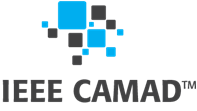CALL FOR PAPERS
Broadband mobile networks experience exponential traffic growth. It is predicted that this trend will continue in the next five with an estimated compound annual growth rate of 0.5 to 1.0, and the (mostly data) traffic carried by mobile networks in 2022 could be over 7 times of that in 2016. This traffic growth presents a huge challenge to both the mobile industry and to academic researchers. Along with increased spectrum efficiency, spectrum bandwidth expansion and traffic offloading through WiFi, deployment of heterogeneous networks (HetNets) is regarded as one of the most promising ways to meet the use of broadband mobile service in both outdoor and in particular indoor scenarios in the next decade. This is because wireless data usage is shifting indoors -nearly 90% of wireless data traffic is generated indoors, especially in high capacity venues such as office buildings and shopping malls. The concept of HetNets has been consisted in the mix of access node types (e.g. macrocells and small cells) as well as technologies.Meanwhile, multiple-input multiple-output (MIMO)techniques have been used to mitigate interference in interference limited HetNets. MIMO brings unique challenges to future indoor/outdoor high-capacity HetNets. For example, inter-cell interference becomes more complicated between small cells equipped with multiple antennas. Despite the current research and development from both industry and academia, there are still many challenges to be addressed and questions to be answered for successful HetNet deployment. These challenges range from the lack of fundamental understanding of HetNet network capacity, to the need of radio access network (RAN) planning and optimisation (P&O) tool for HetNet deployment involving both indoor and outdoor scenarios.
The purpose of this special session is to bring together researchers from industry and academia focusing on capacity study, backhaul planning and optimization for HetNets.
The technical topics of interest to the workshop/special session include, but are not limited to:
- Fundamental capacity aspects
- Radio access network planning and optimization
- Backhaul performance analysis and experimentation
- Radio resource management (RRM) techniques for HetNets (network synchronization, cell range expansion, load balancing, dynamic TDD transmissions, etc.)
- Improved mobility management in HetNets and small-cell discovery mechanisms
- Concepts for energy efficiency enhancements in HetNets and dormant mode operation of small cells
- Channel characterization and modelling for indoor MIMO channels
- MIMO design for indoor small cells
- Interference mitigation and performance analysis for indoor MIMO small-cell networks
- Indoor/outdoor MIMO small-cell network planning and deployment
This special session issupported by theEUH2020 Projects“DECADE”(645705)and “is3DMIMO” (734798).
ORGANIZERS
- Di Yuan, Linköping University, Sweden.
- Nikolaos Pappas, Linköping University, Sweden.
- Xiaoli Chu, the University of Sheffield, UK.
SUBMISSION
Manuscripts must be prepared in the standard IEEE two-column conference format with a maximum paper length of six (6) printed pages (maximum 1 additional page with over length page charge) and submitted via the provided EDAS link.


